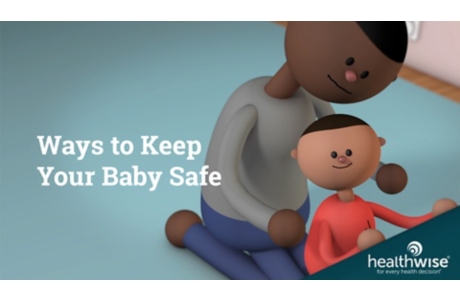Overview
Protecting your baby
Each new learning stage for your baby requires you to pay more attention to prevent an injury. It may surprise you how fast your baby can move from one stage to the next. Being aware of what your baby can do and what skills your baby is likely to learn next will help you prevent injuries.
Be aware of your baby's risk of injury from falling. Use these tips to prevent falls.
- Never leave your baby unattended in high places.
Use care around tabletops, changing tables, a crib with the sides down, and even beds and sofas.
- Don't leave your baby unattended in any infant seat or "sitting" toy.
These include swings. bouncers, and jumpers. Use all the safety straps provided.
- Use sliding gates at both ends of stairways.
Avoid accordion-style gates, because a child's head could get caught in the gate. Look for a gate with openings no bigger than 2 in. (5.1 cm).
- Don't use baby walkers.
Walkers can cause injuries like pinches and falls. And they can cause severe accidents, such as a fall down a flight of stairs.
- Keep your baby away from elevated porches, decks, and landings.
- Never leave your baby alone in or around a bathtub.
A child can slip and fall in the tub or on the wet floor from water that has splashed out of the tub.
- Remove hazards from your home that might cause a fall.
Remember that a baby with a pacifier or other object in the mouth is at risk for face and mouth injuries along with other injuries from a fall.
Protecting young children
Toddlers and young children like to explore, climb, walk, run, and dance. These activities put them at risk for falls and injuries. You can help prevent accidents in the following ways.
- As soon as your baby can walk, lock doors to all dangerous areas.
Keep the keys out of your child's sight and reach.
- Be careful when using equipment such as high chairs and changing tables.
Always use the safety straps. And keep a close eye on your child.
- Use sliding gates at both ends of stairways.
Avoid accordion-style gates, because a child's head could get caught in the gate. Look for a gate with openings no bigger than 2 in. (5.1 cm).
- Keep stairways clean and safe.
Carpeting on stairs should be in good repair. Uncarpeted stairs should be kept clean but not slick. Train your child to hold on to the rail and to walk carefully down each step one at a time. If you have pets, teach your child to keep away from them while on stairs.
- Secure throw rugs to the flooring.
You can use double-sided tape, foam backing, or a rubber pad on throw rugs to keep them from sliding.
- Watch your toddler when they are outside.
Uneven grass, sloping lawns, and hills can make it hard to walk.
- Have your child stay seated when eating or drinking.
Don't allow your child to walk or run with any objects in the mouth. Your unsteady toddler could get face and mouth injuries as well as other injuries from a fall.
- Install window guards.
And don't place furniture, including chairs, close to windows. Make sure windows are closed and locked securely when children are present.
- Don't allow your child to climb on high furniture.
- Install bed rail guards to help prevent falls.
Many are now available that are easy to attach and remove. Make sure openings in rails are small enough to prevent a child from getting trapped. A trapped child can choke or suffocate.
- Make sure your children are safe when they play outside.
- At playgrounds: Slides and monkey bars can be dangerous. Try to find a playground that has a soft surface under the equipment.
- On trampolines: Even with constant adult supervision and protective netting, many children are injured on trampolines. It's best to keep your child off of them.
- On tricycles: Only allow your child to ride solid, stable tricycles that are low to the ground. Make sure your child wears a helmet. And watch where your child rides. Steep downhill slopes can make your child lose control and fall.
Related Information
Credits
Current as of: July 17, 2023
Author: Healthwise Staff
Clinical Review Board
All Healthwise education is reviewed by a team that includes physicians, nurses, advanced practitioners, registered dieticians, and other healthcare professionals.
Current as of: July 17, 2023
Author: Healthwise Staff
Clinical Review Board
All Healthwise education is reviewed by a team that includes physicians, nurses, advanced practitioners, registered dieticians, and other healthcare professionals.


